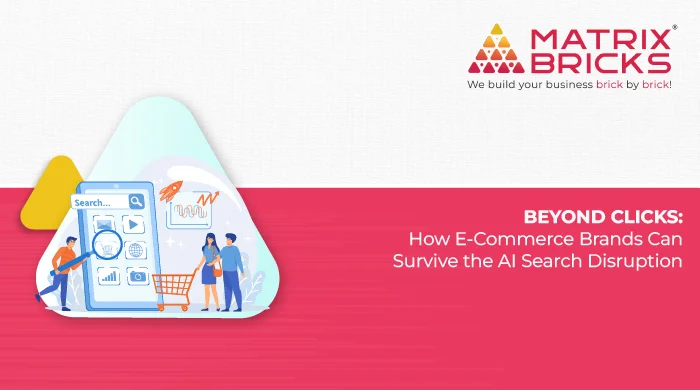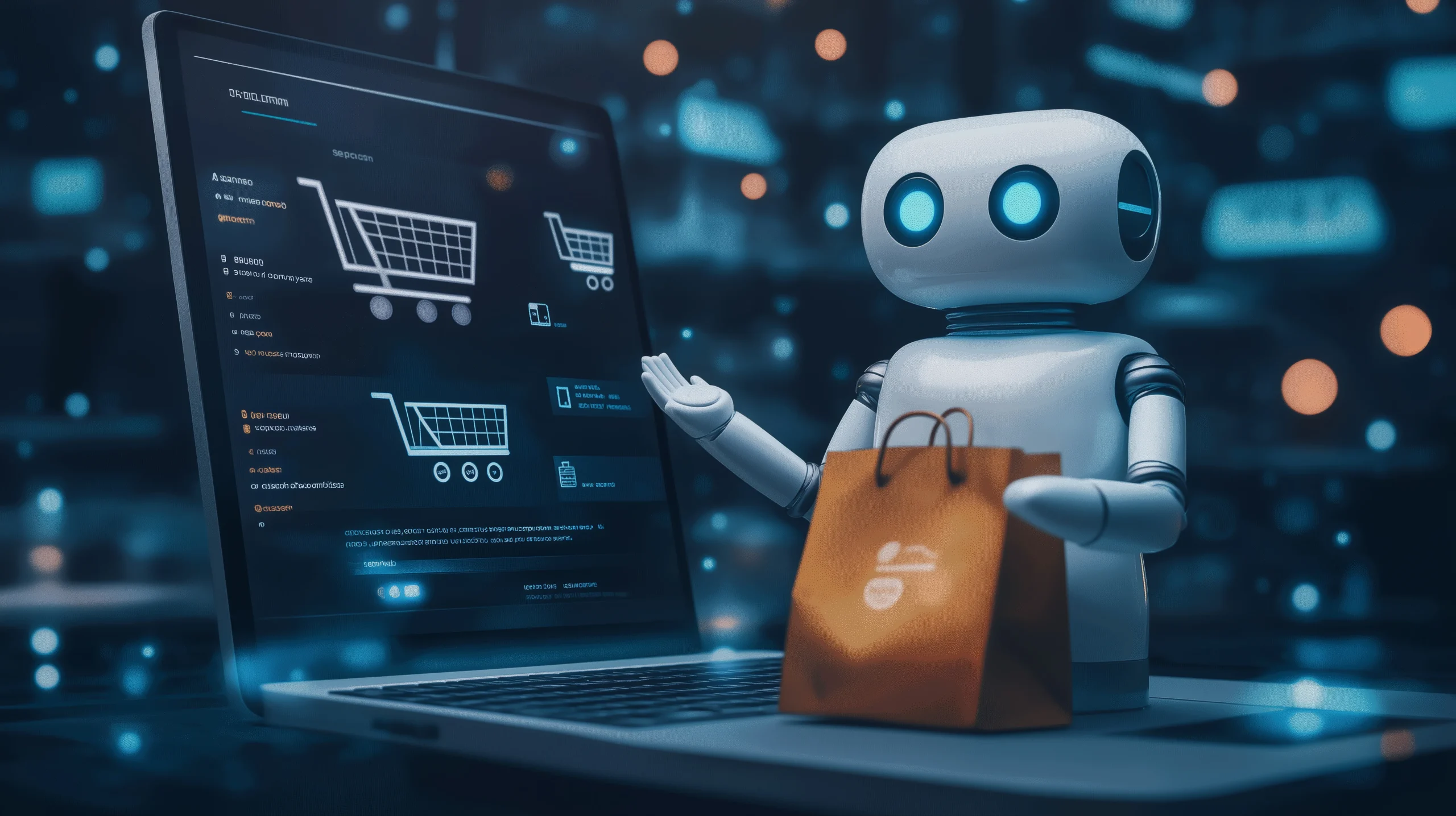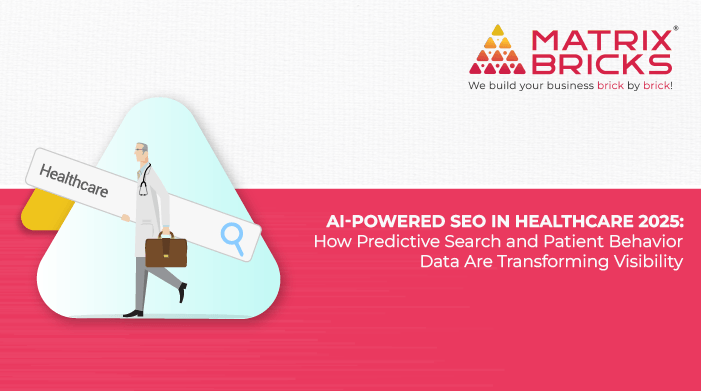
The digital marketplace is evolving faster than ever. As we head to 2026, e-commerce brands are navigating a radical transformation in how customers discover, evaluate, and purchase products online. Traditional SEO-driven organic traffic is no longer the main growth engine, and the cost of paid ads continues to rise.
Artificial Intelligence (AI) is reshaping search behaviour, changing the rules for visibility and conversion. To survive this era of disruption, brands must move beyond clicks, building trust, data-driven visibility, and AI-friendly experiences that attract consumers wherever they are.
This blog explores how your brand can adapt to declining organic reach and rising ad costs while future-proofing your digital presence for e-commerce SEO in 2026.

The Rise of Zero-Click Searches and AI Shopping Assistants
Search is no longer just about ranking first on Google. Increasingly, users find answers and make purchases without ever clicking on the website. These interactions are called zero-click searches, and they are revolutionising how shoppers discover products.
For example, when someone searches “best gaming laptop 2026”, they may receive an AI-generated list of products with ratings, prices and purchase links. The user completes their research or purchases without visiting a single e-commerce website.
The growth of AI shopping assistants such as Google’s SGE, Amazon’s Alexa, and ChatGPT-powered shopping bots accelerates this trend. These assistants curate results, showing only the most relevant and structured options.
For e-commerce businesses, this creates both risk and opportunity:
- Fewer website visits: Even if your product is displayed, users may never reach your site.
- Higher competition for visibility: AI assistants usually display one or two top results — not ten.
- Rising dependency on paid ads: To stay visible, many brands are increasing their ad spend.
- Brand bias in AI recommendations: Well-known brands or those with rich data are more likely to be featured.
To thrive under zero-click SEO, you must make your product data discoverable and optimised for AI interpretation, not just for traditional search engines.
Why Product Content Needs Structured Data
Structured data is the foundation of discoverability in the AI era. If your website’s information is not machine-readable, AI systems will likely skip it. That’s why structured data is vital for product pages.
What is structured data for product pages?
Structured data is a special code (often JSON-LD format) that adds meaning to your content. It helps search engines and AI systems understand your products — not just display them. It defines product attributes such as name, description, image, price, stock availability, brand, and reviews in a standardised language.
Why it matters in 2026
- Increased visibility in AI search: AI assistants depend on structured data to identify relevant products.
- Enhanced product listings: Proper markup improves your chances of appearing in product carousels, knowledge panels, and voice search results.
- Better click-through rates: Even as organic reach falls, rich snippets attract more attention.
- Improved trust signals: Structured data communicates accuracy and consistency to bot users and search algorithms
How to apply structured data effectively
- Use Schema.org markup: Tag every product page with the Product type.
- Include key attributes: Add product name, brand, description, image, SKU, price, availability, and rating details.
- Update regularly: Prices, stock levels, and offers should always reflect real-time information.
- Validate your markup: Use Google’s Rich Results Test to ensure your markup is compliant with the latest standards.
- Connect to feeds: Sync your structured data with shopping feeds and marketplaces for seamless updates.
By implementing structured data for product pages, your site becomes “AI-readable,” helping your products appear in zero-click results, voice searches, and visual shopping carousels.
How to Build an AI-Friendly Content Architecture
The traditional approach to SEO, which focuses solely on keywords and backlinks, is fading. AI-driven search focuses on context, intent, and data relationships. To succeed in e-commerce SEO 2026, your website architecture must serve both users and AI systems.
1. Design for clarity and hierarchy
- Logical structure: Organise pages into clear categories, subcategories, and product sections. This makes it easier for AI crawlers to map the relationships between your content.
- Descriptive URLs: Use readable URLs such as /category/product-name/ instead of random numbers or symbols.
- Consistent interlinking: Link related products, categories, and blogs to help search engines understand context.
2. Create content that matches buyer intent
- Educational guides: Develop buying guides, such as “How to choose a laptop for remote work in 2026.”
- Comparison articles: Publish “X vs Y” content comparing products and brands.
- Problem-solving blogs: Answer questions that shoppers commonly ask in voice queries.
- Video and tutorial content: Engage users visually and support voice assistants that prefer summarised video transcripts.
Rich, relevant content not only supports traditional SEO but also improves your chances of being cited in AI-generated shopping responses.
3. Integrate structured data throughout the site
- Category pages: Use Breadcrumb List markup to show navigation paths.
- Blogs and guides: Apply Article or How-To
- FAQs: Include FAQ Page schema for direct voice assistant responses.
- Products: Maintain a detailed Product schema with reviews and offers.
This integrated approach creates a comprehensive ecosystem that AI systems can easily understand and index.
4. Optimise for AI shopping trends
- Natural language content: Write conversationally so AI systems can interpret user intent better.
- Intelligent internal search: Enable your site’s search bar to recognise voice-like queries.
- Comprehensive tagging: Include attributes like size, colour, and material for every product to enhance assistant accuracy.
- AI-ready chatbots: Integrate on-site assistants that mimic the conversational style of external AI systems.
5. Focus on new success metrics
With fewer direct clicks, evaluate performance using metrics such as:
- Rich result impressions: Track how often your structured listings appear in search.
- Assistant referrals: Identify conversions originating from AI-driven interactions.
- Voice commerce orders: Monitor transactions from voice-enabled devices.
- Brand search volume: Measure how often users search specifically for your brand name.
These metrics reflect your actual presence in the AI-driven discovery journey.

Optimising for Visual and Voice Commerce in 2026
The future of shopping is not typed, it’s spoken and seen. Visual and voice commerce are defining the next wave of AI shopping trends, requiring brands to adapt their product presentation and content strategy.
Voice commerce: Speak to sell
Voice shopping is gaining momentum as users turn to devices like Alexa, Google Assistant, and Siri to buy products hands-free.
To stay ahead:
- Use natural phrasing: Replace keyword-heavy titles with conversational terms. Example: “Find budget smartphones” instead of “Cheap smartphone deals.”
- Include direct answers: Use FAQs and schema so assistants can read your responses aloud.
- Speed optimisation: Voice users expect instant answers; slow-loading sites will lose sales.
- Mobile readiness: Most voice searches come from phones — ensure your site is responsive and fast.
- Optimise long-tail queries: Focus on question-based searches, such as “Which smartwatch has the best battery life?”
Visual commerce: See it, buy it
As image search and AR-based shopping tools continue to grow, your product images must do more than look visually appealing — they must convey meaning.
- Use multiple images: Show every angle, texture, and real-world use.
- Add descriptive alt text: Help AI identify key features.
- Apply structured image data: Use the Image Object schema for each image.
- Enable AR or 3D previews: Let users visualise products before purchase.
- Optimise file size: Fast-loading visuals improve engagement on mobile and social platforms.
Core optimisation priorities for 2026
| Feature | Why It Matters | What to Do |
| Structured data for product pages | Enables AI understanding and appearance in zero-click searches | Add complete JSON-LD markup for every product |
| Conversational content | Powers voice search and AI recommendations | Use natural language, question-based structure |
| Visual optimisation | Improves visibility in image and AR search | Use detailed photos with accurate tags and schema |
| Speed & mobile design | Supports instant, voice-based responses | Implement responsive layouts and compress images |
| Brand trust signals | AI assistants prioritise trusted sources | Collect verified reviews and maintain active profiles |
Declining Organic Reach and Rising Ad Costs
Why organic reach is shrinking
- Zero-click SEO dominance: AI results provide instant answers, bypassing the need to visit websites.
- Fewer visible listings: Rich snippets and shopping panels push organic results lower.
- AI preference for structured data: Sites without structured information lose visibility.
- Changing search behaviour: Consumers trust AI summaries and assistants more than search lists.
Even with strong rankings, brands now see fewer site visits. This makes adapting to e-commerce SEO 2026 critical.
Why are ad costs rising
- More brands competing for fewer clicks: As organic visibility drops, everyone turns to paid media.
- AI-powered ad formats: Sponsored placements within assistants are in high demand.
- Platform monetisation: Search engines and marketplaces are charging more for AI integration.
- Performance pressure: Maintaining ROI becomes harder with rising CPCs (cost per click).
What brands should do
- Diversify acquisition channels by building email, referral, influencer, and marketplace strategies.
- Refine ad targeting by utilising first-party data and AI bidding tools to enhance precision.
- Invest in brand awareness: AI systems tend to rank trusted brands higher in search results.
- Boost conversion rate: Enhance user experience, simplify checkout, and use personalisation tools.
- Track ROI holistically: Measure lifetime value, not just per-click conversions.
Focusing on long-term brand authority and data quality helps offset rising costs and reduced organic reach.
Actionable Strategies for E-commerce Brands in 2026
1. Audit your site for AI readiness
- Structured data check: Ensure all products include up-to-date structured data for product pages.
- Technical audit: Test your site for speed, mobile usability, and crawl depth.
- Voice test: Try searching for your products using a voice assistant — see if you appear in the results.
- Visual test: Upload product photos to Google Lens or Pinterest Lens and analyse discoverability.
2. Create content that AI understands
- Conversational blogs: Write in a natural, human tone that AI can summarise easily.
- FAQ sections: Address common voice queries with schema markup.
- Educational resources: Publish guides that position your brand as an authority in your niche.
- Integrate keywords wisely: Include AI shopping trends and zero click SEO naturally within content.
3. Strengthen brand authority
- Consistent branding: Use the same name, logo, and tone across all platforms.
- Customer engagement: Respond to reviews and Q&A quickly — assistants pick up engagement signals.
- Thought leadership: Contribute insights or blogs that demonstrate expertise in your category.
4. Rebuild your paid strategy
- Utilise structured product feeds to Sync pricing, availability, and descriptions across ad platforms.
- Experiment with AI-based bidding: Let algorithms optimise spend in real time.
- Segment audiences smartly: Tailor messages to loyal customers vs. new prospects.
- Diversify spend: Allocate budgets between Google, Meta, TikTok, and marketplaces to reduce dependence.
5. Optimise for e-commerce SEO 2026 and beyond
- Adopt continuous testing: Reassess voice and visual visibility on a monthly basis.
- Monitor assistant rankings: Track where your brand appears in AI responses.
- Prepare for predictive shopping: Integrate data tools that forecast demand and automate recommendations.
Why Early Adoption Matters
Brands that adopt early to AI shopping trends and zero-click SEO will secure stronger positions before competition catches up. Delaying change can lead to:
- Sharp declines in organic traffic.
- Unsustainable ad costs.
- Poor visibility in AI assistants.
- Reduced brand authority.
By focusing on structured data, conversational content, and AI-driven optimisation now, you future-proof your digital store for e-commerce SEO 2026 and beyond.
Frequently Asked Questions
1. What does zero-click SEO mean?
It refers to search experiences where users receive complete answers directly on the results page or via AI assistants, eliminating the need for a click. Optimising structured data helps ensure your products still appear in these results.
2. Why is structured data essential for e-commerce SEO 2026?
Because AI-driven search depends on understanding data, not just text, structured data for product pages helps your site communicate clearly with AI systems and enhances visibility.
3. What are the main AI shopping trends for 2026?
The key AI shopping trends include visual search, voice commerce, personalisation, and predictive AI recommendations that anticipate shopper needs.
4. How can smaller e-commerce brands compete in the AI era?
Focus on niche expertise, detailed structured data, authentic reviews, and community engagement — smaller brands can rank well if they’re highly relevant and data-optimised.
5. How can I offset rising ad costs?
Increase conversion rates, improve retention, and diversify traffic sources beyond search — for example, via social commerce, affiliate programmes, and loyalty schemes.
Ready to take the next step?
Don’t wait for disruption to catch up.
Get your e-commerce site audited for AI readiness — free 30-minute consultation.
Contact Matrix Bricks today and secure your future in e-commerce SEO 2026.




